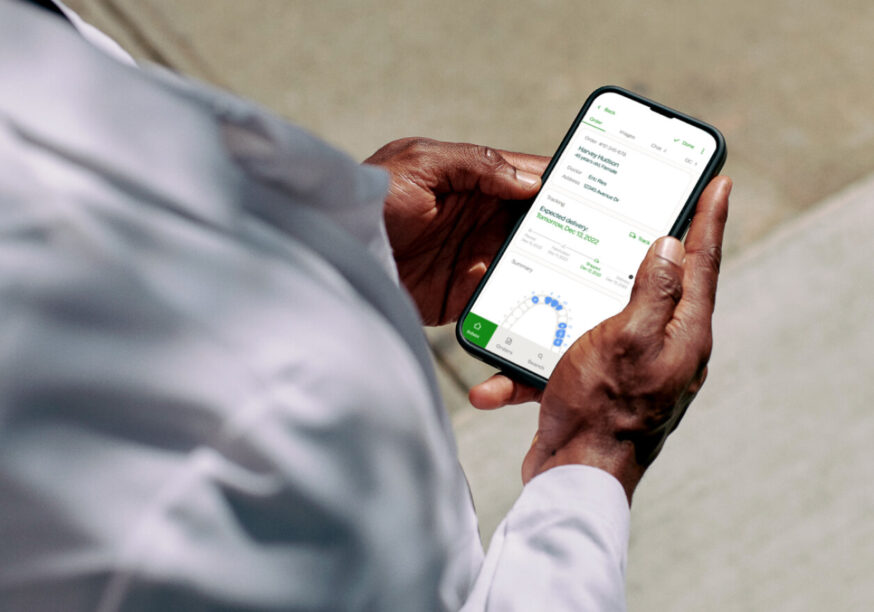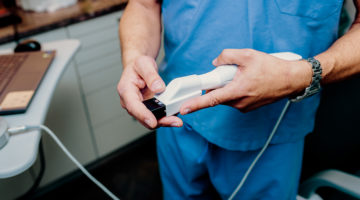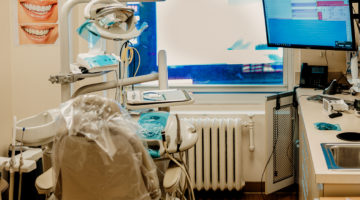What if you could entice patients to come in for regular cleanings and checkups with an experience that reduced discomfort and fears, sped the dental care process up, and made your life easier as well? New dental technology can help with all of that.
The dental industry is going digital and finally catching up with the modern world. While it’s unlikely that you’ll have robotic staff or AI-predictive scheduling tomorrow (or ever?), there are emerging technologies that can improve patient and staff experience right now. Read on for the best in dental technology for 2024.
What is the latest technology in dental care? From intraoral scanners and laser cavity detection to AI and zirconia crowns, here are the most exciting new technologies to merge with your traditional care practices to increase productivity, improve patient experience, and drive more business in the long run.
Technology in dentistry has come a long way and it’s time to modernize your practice where you can afford to. The newest dental technology improves patient and staff experiences. It can help you make better insights into clinical decision-making, allowing for more accurate diagnoses and better-personalized care for each patient.
Here, we’ll explore why you should consider the latest dental technology and use it to attract new patients while upgrading the experiences of existing patients and making your staff’s lives easier once they’re up and running with the latest dental tech.
The latest in dental technology for 2024
The newest dental technology enhances what you’re able to do in your practice. Here are some of the latest innovations you need to know about that address the question of, ‘What’s new in dentistry 2024?’ and, more importantly, how to introduce your patients to new dental technology.
Intraoral scanners
With intraoral scanners, we can finally say goodbye to the uncomfortable, gag-inducing, time-consuming, error-prone practice of physical mold impressions.
Taking physical impressions has been one of the necessary (and unpleasant) hallmarks of modern dentistry. For generations of dentists, mold impressions have been needed to make dentures, implants, and orthodontic appliances.
- For patients – The mold impressions can be uncomfortable, especially for patients with a strong gag reflex.
- For dentists – The process is prone to error, time-consuming, and requires back and forth with the dental lab.
Intraoral scanners are the solution to this dental problem.
With a handheld intraoral device like the one Dandy provides, a dentist rapidly scans a patient’s oral cavity to create a perfect data render of the patient’s mouth. This scan turns into a 3D digital dental model that can then be used to create high-quality dental products, including dentures and crowns. And while this technology is more accurate and comfortable than physical impressions, it also skips the back and forth with labs, by leveraging intelligent processing for rapid scanning and high-precision accuracy.
If you have yet to adopt, this is the top pick to catch up to the newest dental technology in 2024.
Want a FREE intraoral scanner? Partner with Dandy!
CAD/CAM technology
The next piece of the Intraoral scanning puzzle is computer-aided design (CAD) and computer-aided manufacturing (CAM) technologies. With CAD/CAM dentistry, we can rapidly design and fabricate complex restorations that fit, feel, and look better. Those are important benefits of adopting new technology for dentistry!
Thanks to CAD/CAM digitalization, dental treatment processes that used to take weeks to complete can now be done in hours. After the lab receives the 3D model, they can make minor tweaks to ensure proper spacing and alignment.
When it comes to what can increase productivity in a dental office, together, intraoral scanners and CAD/CAM advanced dental technology reduce patient chair time and improve patient experiences and outcomes.
Artificial Intelligence
What’s new in dentistry in 2024? AI technology is on the rise in every industry and dentistry is a part of that boom. Augmented intelligence and AI provide opportunities to enhance patient care, diagnostics and administrative processes.
Some ways AI can be used in dentistry include:
- Imaging and diagnosis: Helping dentists diagnose oral diseases better and faster. AI tools are also helpful when it comes to calling attention to tooth decay in bitewing and peripheral radiographs.
- Robotics and automation: New dental technology is looking at how robots could be used to automate repetitive tasks like tooth preparation, the placement of implants and even orthodontic adjustments.
- Data analysis: As AI systems acquire health data, they can help dentists offer more personalized care and better diagnose particular dental conditions.
- Administrative support: New dental technology like AI tools can help streamline admin tasks, from handling appointment scheduling, to improving billing processes, and even helping you write copy for your mailers and marketing emails.
There are numerous ways AI can improve efficiency in your practice and enhance your patients’ experiences as long as its done ethically while keeping patient safety and data privacy in mind at all times.
Laser detection
One of the results of more widespread fluoride use over time is stronger enamel, which is great — one small caveat is that harder outside enamel may make it more difficult to detect early caries, especially in X-rays.
Enter dental laser detection, a form of technology in dentistry that is over 90% accurate in finding decay not found with an explorer or bitewing x-rays. Painless, non-invasive, and working without x-ray exposure, new dental technology like laser detection can help your patients with early detection and give your practice more data-driven, reliable measurements.
Digital radiography
X-rays are still widely used across the dental industry for daily operations. But traditional x-rays relied on film processing. That was a slow and costly process that also required dental offices to physically store and share the copies.
Direct digital radiography has changed that. This advanced form of X-ray inspection quickly renders digital radiographic images on a computer screen.
A dental professional can take digital X-rays both inside (intraorally) and outside (extraorally) of the mouth. Once scanned, that file is then stored in a physical server or the cloud, making for much easier dissemination.
Other advantages of this dental technology include:
- Reduced exposure times
- Real-time dental applications
- Improved detail, SNR, and linearity
- Ease of storage and transfer
- Immediate feedback
Teledentistry
The ideal dental relationship has historically taken place face to face (masked face to open mouth, if we’re being specific), but technology in dentistry makes it possible for dentists to communicate with patients and even remotely perform examinations with teledentistry.
And while teeth can’t be cleaned and cavities filled over Zoom, teledentistry appointments can extend the reach of your practice, especially in situations not requiring a recommendation of acute care. Not all appointments are created equally, and with the right management and careful application, teledentistry can save you time and your patients’ travel time by expediting follow-ups, second opinions, or pre-authorizations over a phone, tablet device, or computer.
Zirconia crowns
Dental crowns made of porcelain-fused-to-metal (or full-gold) have been the standard for decades. Materials technology is finally finding superior, non-metal replacements, including zirconia.
It’s hard to fit all of the benefits of these crowns in a small space, but zirconia crowns are:
- Stronger, whether using either a monolithic, layered, or high-translucency zirconia
- Customizable, as the material when molded is extremely malleable — matching the existing tooth with precision
- Biocompatible, because zirconia is non-toxic, hypoallergenic, and metal-free, meaning little to no negative patient reactions.
- The right color, especially when combined with Dandy’s intraoral scanning technology, with shade-matching workflows.
Explore Dandy’s Zirconia Crowns
Digital records and charts
Maintaining comprehensive and accurate patient records is an essential part of general dentistry and to keep up with dental technology in 2024. Diligent record keeping is a vital skill that empowers a dentist to deliver quality patient care and follow-up.
But paperwork can be a significant administrative burden for every dental clinic.
Dental records can contain information about clinical examinations, diagnoses, dental procedures performed, prognosis, and the patient’s medical history. Much of this paperwork consists of highly sensitive, personally identifiable information, which you’re legally required to maintain and safeguard.
Yet, many dental clinics still rely on outdated paper charts and documentation for their record keeping. It’s messy, disorganized, time-consuming, and requires a lot of storage space.
Enter dental technology for the win to simply your office!
Maintaining digital records is the better, more efficient way. Advantages of electronic dental health records include:
- Easier to maintain and access accurate, up-to-date information about patients at the point of care
- Enables secure sharing of health records with patients or other clinicians
- Reduces costs related to paperwork and administrative burden
- Strengthens privacy and security of patient data
Virtual reality
Virtual reality is one of the latest developments in dental technology that can help provide better care to patients—through distraction techniques!
Augmented reality or virtual reality (VR) headsets can help transport patients to a relaxing, serene environment while you’re performing work on them in your chair. Research has shown that there’s a drop in a patient’s perceived pain when they’re using AR or VR.
Dentists can also use augmented reality to explain dental information to patients in an easy-to-understand format, showing patients what the treatment will look like so they feel more prepared and the dentist can improve their accuracy.
Overcoming challenges in adopting new dental technology
The challenges of digital dentistry are practitioners’ proximity to new dental technology, industry training for new processes, and financial blockers. However, taking your practice digital does not just mean adopting intraoral scanning but instead, it can look like digitizing patient records and scheduling and partnering with digital dental labs that use cutting-edge technology to fabricate restorations.
Keep your team informed
You might face some pushback from staff as you bring in new dental technology and it takes time to learn the systems. Remind them that ultimately, this will make their jobs easier and no, AI won’t replace them! Enlist professional help teaching them the new dental tech and show them your human side as you encounter struggles and make mistakes while learning. With some dedicated learning, you’ll all be pros in no time.
How to navigate training and implementation
Seek out user-friendly systems – Do research into the various types of dental technologies available as well as the brands within each niche. Use systems that are vetted and well-reviewed by your peers.
Set aside time for learning and training – Join your staff during training sessions and address any questions or concerns they have. Take your time as you bring innovative dental tech into your practice. Ensure you and everyone are using it properly before rolling it out to use on patients.
Remind everyone of why you’re doing this – Technology can feel clunky at first but once you’re comfortable using it, it should enhance your practice and make everyone’s jobs simpler while speeding up systems. You’ll also have an easier time attracting new hires—and new patients!—once they see your dental practice is an innovative one that’s constantly looking to revamp for the better.
Think about where you’ll be a year from now
The benefits of dental technology are that once you’re comfortable using them, you’ll be able to free up time and energy for other things in your practice. Your patients will appreciate the enhanced care and improved analysis of their health and you’ll be able to make better assessments that systematizes procedures and reduces time.
As you’re pondering what is the latest technology in dental care that can improve your patients’ experiences and integrate processes, keep the new technology for dentistry mentioned above in mind to help bring your practice up to date.
Dental technology 2024: Go digital with Dandy
The dental world is changing rapidly. Technological advancements in dentistry are spurring that transformation.
With increasing marketplace competition and more demanding patients, a dental clinic can’t afford to simply stick with the status quo—not when their competitors are embracing the digital future. By adopting new dental technology, you can create internal and external efficiencies that empower you to better serve your patients.
That’s where Dandy comes in.
Our platform is designed to modernize dental practices by making their entire process digital — from start to finish. With intraoral scanners and CAD/CAM design, our goal is to create lift in everything you do.
Have you considered going digital? Dandy can help you get started today.
Sources:
Journal of the American Dental Association. Intraoral Scanners. https://jada.ada.org/article/S0002-8177(21)00312-3/fulltext
NCBI. Understanding Dental CAD/CAM for Restorations—Accuracy from a Mechanical Engineering Viewpoint. https://pubmed.ncbi.nlm.nih.gov/26734668/
International Atomic Energy Agency. Digital Radiography. https://www.iaea.org/resources/rpop/health-professionals/radiology/radiography/digital-radiography
Health IT. Advantages of Electronic Health Records. https://www.healthit.gov/faq/what-are-advantages-electronic-health-records
ADA News. Artificial intelligence and dentistry https://adanews.ada.org/ada-news/2023/june/artificial-intelligence-and-dentistry/
Join thousands of dental professionals who get our emails ever week!
We send emails on Tuesdays. Keep an eye out for the next one!




